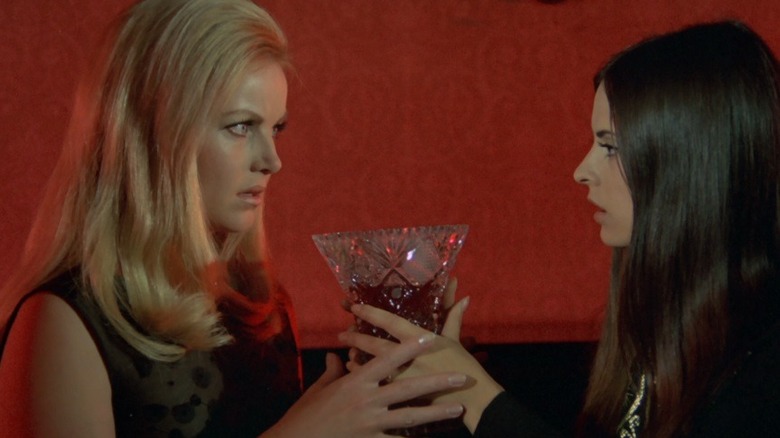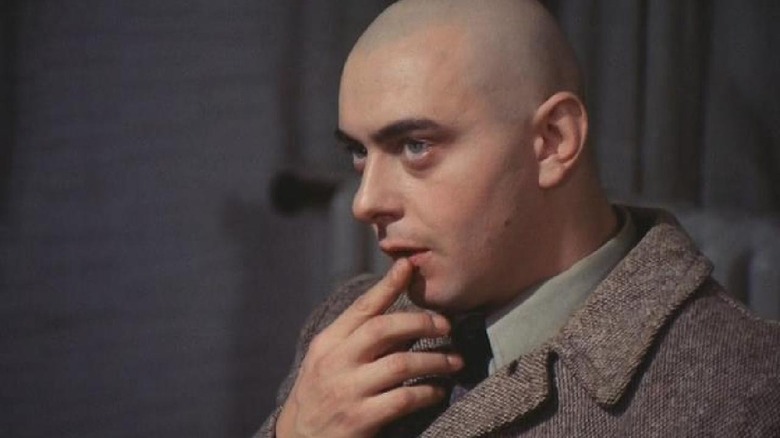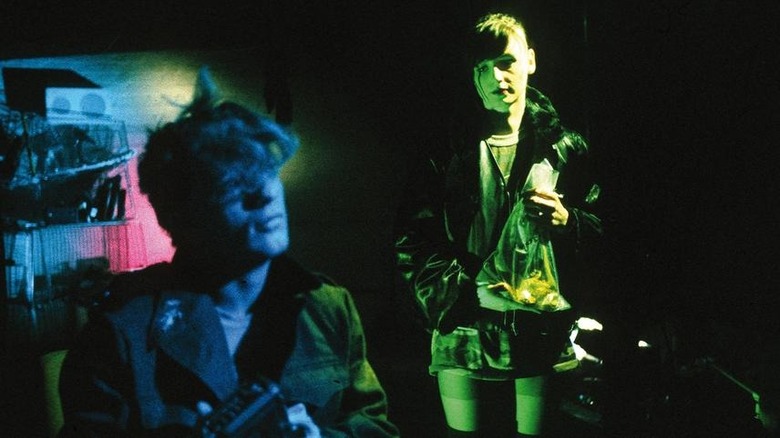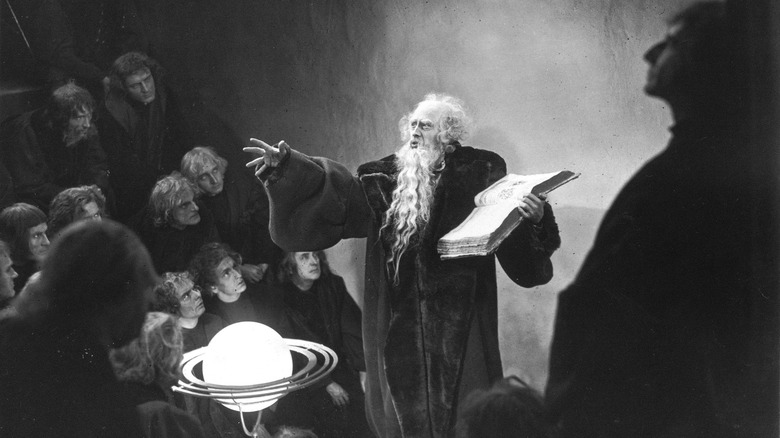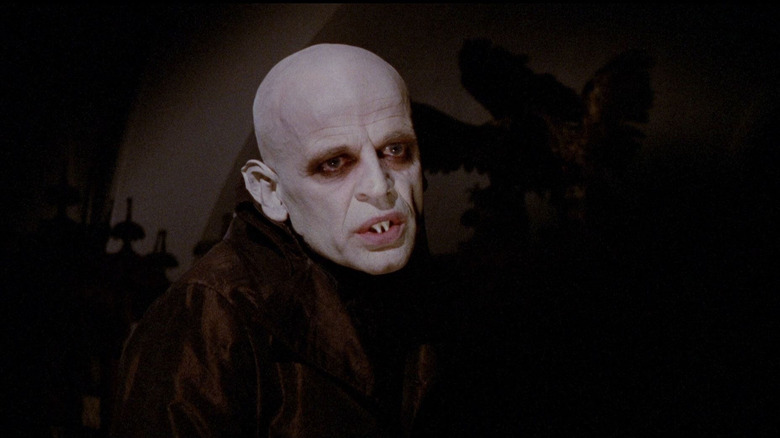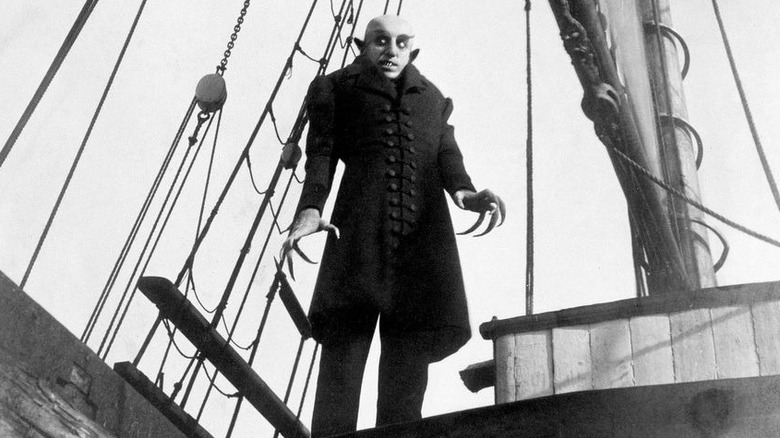The 12 Best German Horror Movies Ranked
Germany has given the world some of its finest filmmakers, Lotte Reiniger, Ernst Lubitsch, Douglas Sirk, Wim Wenders, and Rainer Werner Fassbinder, to name but a few, as well as groundbreaking movements like German Expressionism and New German Cinema. The country has also produced some of the best horror movies in history, from terrifying silent classics about the supernatural to gripping crime thrillers and nerve-shredding cyberpunk tales.
While it's impossible to cover the depth and breadth of German horror movies in a short list, we can touch on some of the greats. Listed below are the 12 best German horror movies. All of these films prove that horror has always been political, mining the fears and anxieties of the times in which they were created to make a point about the world around us and that the genre has always been — and always will be — a vital part of movie history.
12. Vampyros Lesbos (1971)
Stylish and seductive, Jesús "Jess" Franco's landmark vampire film is an intriguing examination of desire and repression. Countess Nadine Carnody (Soledad Miranda) lures beautiful women (specifically blondes — she has a type) to her Turkish estate, which just so happens to have belonged to Count Dracula. One of her targets is Linda Westinghouse (Ewa Strömberg), who catches the Countess' erotic lesbian floor show one night and finds herself fascinated and attracted to her. When she visits the Countess at her estate, she learns that she is a vampire, and Linda must decide whether to become a vampire herself or return to her former life.
"Vampyros Lesbos" is slow and dreamy, weaving in extended love scenes and psychedelic music. While some viewers might balk at the film's languorous pace, the overall effect is a delightful sort of hypnosis that mirrors the Countess' powers of persuasion. The film delves into the stigmatization of homosexuality, especially in women, when Linda wakes up in a hospital and meets Agra (Heidrun Kussin), the Countess's former lover who has been institutionalized for her obsession. Though the movie does not end happily for the Countess, it does not condemn her or Linda for their passions. It suggests that there is far more to Linda's experience than a mere dream and that it will stay with her for the rest of her life.
11. Tenderness of the Wolves (1973)
Based on a true story, Ulli Lommel's "Tenderness of the Wolves" tells the story of Fritz Haarmann, a serial killer taking advantage of his police connections as an informant and inspector to procure victims and hide the evidence of his crimes. Fritz surrounds himself with petty criminals, giving them stolen goods, often passing off the flesh of his victims as pork and lamb he "confiscates." These associates have varying degrees of knowledge of the extent of Fritz's crimes. There's a clear indictment of sympathizers and collaborators in this film that would have resonated deeply in 1970s Germany.
Writer Kurt Raab stars as Fritz, and his performance is both beguiling and repulsive. There's an odd shyness in Fritz that makes the horrific nature of his crimes that much more shocking. Although Raab isn't afraid to show the monster beneath Fritz's unassuming exterior, he also doesn't shy away from what enables Fritz to get away with his crimes for so long: his charm. Fritz can be funny and gregarious, and he uses his position with the police department (and his affability) to his advantage. It's an unsettling portrait of a terrifying man that reminds viewers of the wolves in sheep's clothing that surround us.
10. Decoder (1984)
"Have I told you about my new death frogs?" Muscha's "Decoder" is the most surrealist film on this list, blending industrial music, sociopolitical commentary, and neon filters to make a cyberpunk "Alphaville." F.M. (F.M. Einheit) works at H Burger, which uses Muzak to keep its customers happy and smiling. When F.M. discovers that the music is a vast conspiracy to keep people docile, he records a track of noise rock (including the dying squeaks of a death frog) to spur people to action against the government and the corporations that want to control them.
If Mario Bava and Andy Warhol joined forces to make the last film in human history, it would be "Decoder." The movie is experimental and expressionistic, blending vibrant neons and crisp metallics with the detritus of modern life: a landfill, a fast food joint crowded with people, and a dirty city street. Chaotic and cool, "Decoder" is a warning to oligarchs and a wake-up call to audiences to watch out for the Muzak in their own lives.
9. The Golem: How He Came into the World (1920)
Paul Wegener and Carl Boese co-directed this early Jewish horror film. "The Golem: How He Came into the World" stars Wegener as the titular creature, whom Rabbi Loew (Albert Steinrück) builds out of clay and then animates using a magical ritual that summons a spirit to bring the Golem to life. The Rabbi uses the Golem to save the Jewish people from the edicts of the Holy Roman Emperor, who seeks to drive all the Jews from their homes in Prague. Though the plan works initially, the Golem soon falls under malefic control and turns against his creator and the people he was built to protect.
"The Golem: How He Came Into the World" is a clear precursor to James Whale's "Frankenstein." The two films even share a cinematographer in Karl Freund. With moody visuals, striking performances from the menacingly stoic Wegener and the desperate Steinrück, and a macabre story of a man bringing an inanimate creature to life and then losing control of it, "The Golem" set the tone for future horror cinema and still stands as one of the best Jewish horror films in history.
8. Faust - A German Folktale (1926)
Imagine if "How did they do that?!" were an entire movie, and you'd have F.W. Murnau's technical tour de force "Faust — A German Folktale." Based (of course) on German folklore and Goethe's famous play of the same name, the film tells the story of an alchemist named Faust (Gösta Ekman), who finds himself caught up in a wager between Mephisto (Emil Jannings) and an Archangel (Werner Fuetterer), with the fate of the entire world at stake. In the end, love triumphs over evil, though Faust and all those around him suffer tremendously.
Though the film is nearly a century old, its special effects still manage to shock and fill audiences with wonder today. When Faust, desperate to save his town from a plague, calls Mephisto at a crossroads, rings of light surround Faust and travel heavenward, shining brightly on his face as they move. When Mephisto offers Faust a deal he can't resist, words appear in a blaze of fire and smoke on a blank scroll. The use of light and shadow is breathtaking, and the mindblowing effects buttress a timeless story of good vs. evil.
7. The Fan (1982)
Simone (Désirée Nosbusch) is obsessed with a pop star named R (Bodo Steiger). She doesn't eat or sleep or go to school. She just listens to his music and walks around the city daydreaming about him. When she shows up at a recording studio to meet him, he takes a fancy to her and invites her to his friend's house. They have sex, but R asserts that there's nothing else between them — despite Simone's protestations of love. What follows is the inevitable but still horrifying result of Simone's single-minded obsession with R.
Most of the film unfolds through Simone's soporific narration, which almost entirely consists of her reading letters she's written R. The whole film is slow and dreamy, even the shocking third act. This deliberate pacing makes the finale more disturbing. Though Simone's obsession is frightening, it becomes hard to see her as a villain due to director Eckhart Schmidt's efforts to place the viewer in Simone's shoes. We see her victimized repeatedly by men throughout the film — by her neglectful father, postal service workers who mock and leer at her for waiting for responses from R, a man who picks her up hitchhiking and attempts to rape her, and R himself — and our sympathies lie more with Simone than with anyone else in the film. It's a disturbing place for the viewer to find themselves in, making "The Fan" an unforgettable and highly provocative German horror film.
6. The Testament of Dr. Mabuse (1933)
Fritz Lang has two films on this list for a good reason. This master of cinema has multiple masterpieces under his belt, including the watershed sci-fi film "Metropolis." "The Testament of Dr. Mabuse" is the sequel to his silent film "Dr. Mabuse the Gambler," and it features the titular Dr. Mabuse (Rudolf Klein-Rogge) confined to a mental institution. Mabuse still controls the criminal underworld, though, and he embarks on a systematic reign of terror designed to make the entire system crumble and fall under his control.
Banned by Joseph Goebbels' Ministry of Propaganda, "The Testament of Dr. Mabuse" is a piercing look at the insidious power wielded by Hitler and a chilling examination (and eerie foreshadowing) of how that power diffuses through underlings who are "just following orders." Lang wasn't a fortune teller back in 1933. He simply saw the Nazis for what they were, and his film reflects the importance of fighting against that creeping evil with everything you have.
5. Nosferatu the Vampyre (1979)
Taking a unique approach to the familiar tale of Dracula, Werner Herzog's 1979 remake of F.W. Murnau's 1922 classic "Nosferatu" (which also appears on this list) manages to be both true to its source material and wholly original. Klaus Kinski's Count is plagued with ennui, striking a far more tragic figure than many of his cinematic predecessors. He laments that he cannot grow old or die, and the one thing he wants in this world is not blood but love.
The object of his desire is, of course, Lucy Harker, and Isabelle Adjani plays her as an ethereal yet grounded woman who is deeply in touch with her intuition and perpetually haunted by her love for her husband Jonathan (Bruno Ganz) and her fear of Count Dracula. It's a mesmerizing performance from an incomparable actress. Between the terrifying frisson between Adjani and Kinski and the gorgeous yet melancholy images that Kinski and cinematographer Jörg Schmidt-Reitwein capture, "Nosferatu the Vampyre" is a "Dracula" adaptation for the ages.
4. Nosferatu: A Symphony of Horror (1922)
F.W. Murnau's adaptation of Bram Stoker's "Dracula" might not have been authorized, but it certainly still holds the title for the most chilling cinematic version of Stoker's classic novel. In this important German Expressionist film, Count Orlok (an iconic Max Schreck) employs real estate agent Thomas Hutter (Gustav von Wangenheim) to buy a house in Thomas's hometown of Wisborg. Orlok travels there, bringing a plague with him and setting his sights on Thomas' young wife, Ellen (Greta Schröder), and her lovely neck.
With its spidery lead actor and eerie visuals, Murnau's film is still the creepiest "Dracula" adaptation. The carriage that transports Hutter to Orlok's castle seems to teleport, moving forward at occasionally impossible speeds, and a negative image even seems to suggest that they are moving to another dimension or through the gates of Hell itself. Orlok's terrifying claws form shadows that seem to take on lives of their own. The speed and strength with which Orlok carries his coffin are horrific, especially when the lid moves on its own. Age (and a copyright lawsuit) have done nothing to dull the sharp terror of Murnau's film. It remains as unsettling now as it was over a century ago.
3. The Cabinet of Dr. Caligari (1920)
Robert Wiene's cinematic nightmare is the definitive German Expressionist film. The exaggerated angles seem to exist outside of nature. With angular and disorienting visuals everywhere, everything looks impossibly wrong. None of the seams should fit together. It's a metaphor for life that resonates with audiences: accepting unreality as reality and going on with life in the face of terrifying circumstances. The same holds for the narrative. A hypnotist named Dr. Caligari (Werner Krauss) uses his sideshow attraction, a somnambulist named Cesare (a mesmerizing Conrad Veidt), to commit murder. The lines between waking and dreaming — and between life and death — are so blurred that they seem meaningless.
"The Cabinet of Dr. Caligari" is a masterpiece of cinema. Though it's over 100 years old, it seems avant-garde in its cinematography, blocking, and set design. Even the way Cesare moves feels modern. He's graceful but inhuman, moving like an otherworldly acrobat trying not to leave footprints on the ground. Words appear onscreen as Dr. Caligari is haunted by his thoughts. The film renders the impossible possible, making the audience doubt their senses and their handle on reality. It is one of the most important horror movies ever made, and its influence is immeasurable.
2. M (1931)
The second of Fritz Lang's films to appear on this list, "M" was Lang's first sound film. The use of sound in this crime thriller is impeccable, turning Edvard Grieg's "In the Hall of the Mountain King" into the call of death. Hans Beckert (Peter Lorre) is a child murderer terrorizing Berlin, and he's fond of whistling the tune when he approaches his victims. The police can't find him, and the town's criminals are tired of the endless raids, so they decide to hunt Beckert down to escape the police presence and the accusations that they are the same as the child killer. It's a tense thriller that methodically tightens around the viewer's neck like a garrote.
Lorre is magnificent, portraying the murderer's madness, his terrifying charm when he lures the children to their deaths, and his pathos in the face of his would-be executioners with frenzied dedication. He gives a powerhouse performance, especially when the criminal underground puts Beckert on trial and the murderer pleads for his life, pleading he can't fight the impulses that drive him to his horrible deeds. It's a chilling moment, matched only by the opening scene showing the disappearance of Elsie Beckmann (Inge Landgut). As we hear Elsie's mother (Ellen Widmann) calling her name, Lang cuts to Elsie's empty plate at the dinner table, then her ball rolling into frame in a field, and then to the balloon that Beckert bought her getting tangled up in some power lines just before he fades to black. It's a sobering, terrifying moment that says more about Elsie's last moments than anything else could.
1. Vampyr (1932)
"Vampyr" was Carl Theodor Dreyer's first sound film first sound film, and the liminal nature of his (highly successful) attempt to bridge the gap between the new technology and the visual vocabulary of silent cinema is a perfect match for the unsettling nature of a vampire tale. In the film, Allan Gray (Julian West) travels near the village of Courtempierre and receives a mysterious package from an equally mysterious man, who leaves instructions that it is to be opened upon his death. Gray's wanderings lead him to a manor, where he witnesses the man's murder. He opens the package to find a book about vampires, which sets him off on a terrifying and dangerous investigation.
The effects in "Vampyr" are just as jaw-dropping as those in Murnau's "Faust," but there's elegiac poetry in "Vampyr" that earns it the top spot on this list. Shadows dancing along a riverbank, a man watching his own funeral procession through the window of a coffin, a weather vane silhouetted against the sky — these are all classic cinematic moments in Dreyer's hands. Dreyer was a master of his art (his "The Passion of Joan of Arc" is one of the best films of all time, sound or silent), and his ability to craft unforgettable images with light and shadow makes "Vampyr" the best German horror film of all time.

